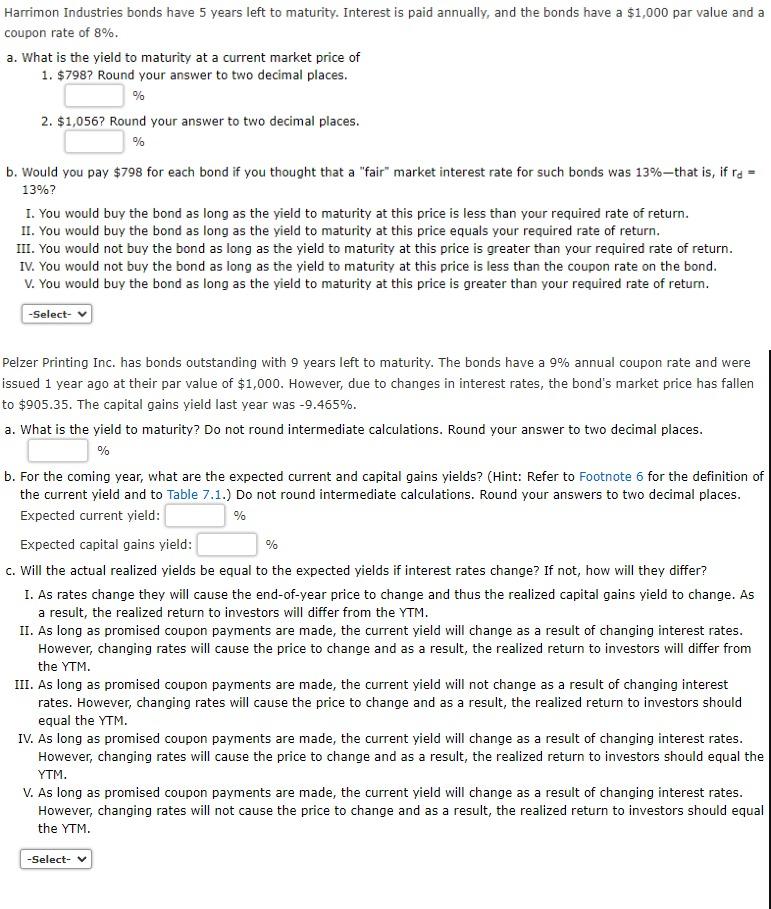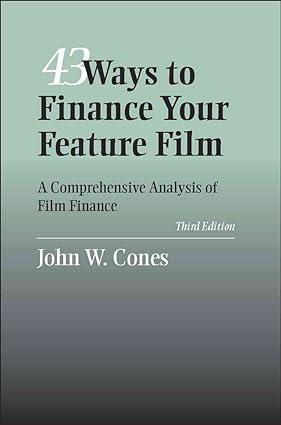Question
13) Harrimon Industries bonds have 5 years left to maturity. Interest is paid annually, and the bonds have a $1,000 par value and a coupon
13)
Harrimon Industries bonds have 5 years left to maturity. Interest is paid annually, and the bonds have a $1,000 par value and a coupon rate of 8%.
- What is the yield to maturity at a current market price of
- $798? Round your answer to two decimal places.
- $1,056? Round your answer to two decimal places
- Would you pay $798 for each bond if you thought that a "fair" market interest rate for such bonds was 13%that is, if rd = 13%?
- You would buy the bond as long as the yield to maturity at this price is less than your required rate of return.
- You would buy the bond as long as the yield to maturity at this price equals your required rate of return.
- You would not buy the bond as long as the yield to maturity at this price is greater than your required rate of return.
- You would not buy the bond as long as the yield to maturity at this price is less than the coupon rate on the bond.
- You would buy the bond as long as the yield to maturity at this price is greater than your required rate of return.
14)
Pelzer Printing Inc. has bonds outstanding with 9 years left to maturity. The bonds have a 9% annual coupon rate and were issued 1 year ago at their par value of $1,000. However, due to changes in interest rates, the bond's market price has fallen to $905.35. The capital gains yield last year was -9.465%.
- What is the yield to maturity? Do not round intermediate calculations. Round your answer to two decimal places.
%
-
For the coming year, what are the expected current and capital gains yields? (Hint: Refer to Footnote 6 for the definition of the current yield and to Table 7.1.) Do not round intermediate calculations. Round your answers to two decimal places.
Expected current yield
-
Will the actual realized yields be equal to the expected yields if interest rates change? If not, how will they differ?
- As rates change they will cause the end-of-year price to change and thus the realized capital gains yield to change. As a result, the realized return to investors will differ from the YTM.
- As long as promised coupon payments are made, the current yield will change as a result of changing interest rates. However, changing rates will cause the price to change and as a result, the realized return to investors will differ from the YTM.
- As long as promised coupon payments are made, the current yield will not change as a result of changing interest rates. However, changing rates will cause the price to change and as a result, the realized return to investors should equal the YTM.
- As long as promised coupon payments are made, the current yield will change as a result of changing interest rates. However, changing rates will cause the price to change and as a result, the realized return to investors should equal the YTM.
- As long as promised coupon payments are made, the current yield will change as a result of changing interest rates. However, changing rates will not cause the price to change and as a result, the realized return to investors should equal the YTM.

Step by Step Solution
There are 3 Steps involved in it
Step: 1

Get Instant Access to Expert-Tailored Solutions
See step-by-step solutions with expert insights and AI powered tools for academic success
Step: 2

Step: 3

Ace Your Homework with AI
Get the answers you need in no time with our AI-driven, step-by-step assistance
Get Started


